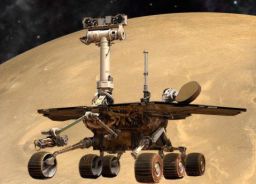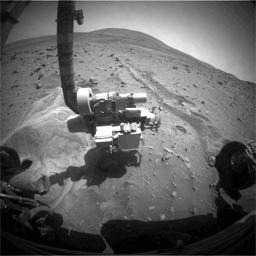A.J.S. Rayl • Nov 12, 2009
Mars Exploration Rovers Update: Spirit Begins Extraction Process
On Monday, November 16, 2009, Mars Exploration Rover Spirit will begin the much-anticipated, weeks-long process of extricating itself from a patch of powdery soil that stopped it in its tracks six months ago. It will begin by driving forward to the north, following its tracks out, even though its right front wheel is broken and immobilized.
NASA’s Doug McCuistion, director of the Mars Exploration Program at the space agency’s headquarters in Washington D.C., made the announcement earlier today during a press teleconference that also featured mission team members. “This process could take quite a while if it’s possible at all to get Spirit out of its predicament,” he said.
Spirit has been embedded within an area the team dubbed Troy since April 23, 2009, when it first encountered the powdery patch. The patch is on the edge of what turned out to be an ancient, shallow, then-hidden impact crater. As the rover was driving south to its next destinations -- two volcanic features named for rocket pioneers Robert Goddard and Werner von Braun -- its left three wheels broke through a crust -- known as duricrust -- covering what turned out to be the boundary of an approximate 8-meter (26-foot) diameter, 20-centimeter (7.9-inch) deep crater.
At least Spirit had the good fortune to rove into a “geological treasure trove,” as Deputy Principal Investigator Ray Arvidson, of Washington University St. Louis, defined the Troy area. For the last six months, the rover has been anything but idle. Rather, it has been examining in detail its surroundings with tools on its robotic arm and its camera mast. In the process, it’s discovered more mission gems. "The soft materials churned up by Spirit's wheels have the highest sulfur content measured on Mars," he pointed out.
After weeks of Spirit’s research and the scientists’ analyses, Spirit, they found, is straddling the edge of the crater that was filled long ago with these now powdery sulfate-bearing soils produced in a hot water or steam environment. The deposits in the crater formed distinct layers with different compositions and tints, and they are capped by a crusty soil. It is that powdery soil that Spirit's left wheels broke through. [The buried crater lies mainly to Spirit's left.]
A few drive attempts to get Spirit out in early May caused the rover to began sink deeper into the crater’s soft edge. Worse, the rover slipped to rest, at a 60-degree angle, just over a small pile of rocks, one of which is triangular in appearance, its primary point touching the belly of the rover. It was at that point the team ordered Spirit to not spin its wheels at all.
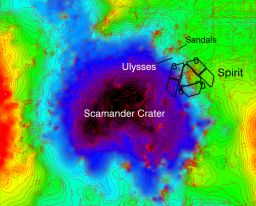 Topographic map of Spirit's location at Troy
Topographic map of Spirit's location at TroyThis topographic map of Spirit's location at Troy represents low elevations in black, purple, and blue and high elevations in red. It was developed based upon Spirit's camera images of the location, taken before it got mired at Troy. The topographic model has had a regional slope removed, which reveals that Spirit's left wheels are sitting inside a subtle depression that the team has named Scamander crater. The right-side wheels are outside the depression.Credit: NASA / JPL-Caltech / Ohio State University
On Earth however Mars Exploration Rover (MER) team members spun a lot of wheels during the summer, experimenting on maneuvers and exit strategies with ground rovers, working up a plan for Spirit to get out of the Martian mess it accidentally and suddenly found itself in six long months ago. “We think from the testing on Earth that we have seen what is likely a worst case scenario,” said John Callas, project manager for Spirit and Opportunity at the Jet Propulsion Laboratory (JPL), where the twin robot field geologists were designed and built. But, he qualified: “We haven’t found a clear solution.”
“We have faced embeddings before, but this is the most complicated and complex,” added Ashley Stroupe, a JPL rover driver and Spirit extraction testing coordinator. “We’re going to have to be careful in maneuvering the vehicle.” One main concern is that the pointed rock touching the rover’s belly could gouge Spirit if the rover makes a wrong move. Additionally, there’s a small cavity in its belly, a notch where a lifting mechanism that helped the rover stand after landing once was, which could catch on the rock if the rover headed backwards, it’s normal mode of driving. That’s why driving forward or north is the better route out.
Complicating that plan is the fact that Spirit's right-front wheel has been inoperable since 2006, possibly because of wear and tear on a motor as a result of its longevity, something that had added a tricky dimension to development of exit strategies. “We’re going to have to be careful in maneuvering the vehicles,” said Stroupe.
Spirit’s coming extraction has been a long time coming and it’ll be a long time going. Despite all the testing on the ground, the team has no idea exactly how long the extraction will take or even if what they’ve tried in simulation tests on Earth will work on Mars -- “there are no guarantees,” said Stroupe -- they did say this process will at least take weeks.
The engineers plotted an escape route that is “the path of least resistance,” as Callas described it. It will send the rover forward and, with a little of that MER serendipity, away from the crater. “Our best plan at this point is to try and drive forward, retracing our steps [sic] we drove in,” Stroupe announced. “We believe this softer material may be easier to plow through rather than break through the crust and cut new tracks. So if we follow our old tracks out, we may be able to make better progress. This is essentially, at the beginning, a relatively flat path. We don’t have to try to climb up hill to get out and eventually it becomes down hill and gravity may become our friend. Driving backwards is undesirable because we would have to climb up a rather steep hill to continue in that direction,” she added.
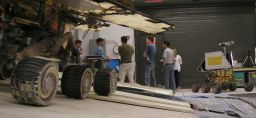 Doubling up test rovers
Doubling up test roversMER engineers and scientists spent the summer at JPL testing possible maneuvers Spirit might use for escaping from a patch of soft soil where it is embedded in an area called Troy. In this image from Aug. 21, 2009, members of the rover team at JPL plan for starting to use a second rover in the set-up. The Surface System Test Bed (SSTB) Lite rover (far right) is not as heavy than the primary engineering test rover, called the Surface System Test Bed or SSTB rover(left foreground). The lighter version does not carry a full science payload and robotic arm, as Spirit, Opportunity and the SSTB do. Making comparisons between motions of the two test rovers in duplicated drives will aid the rover team in interpreting effects of differing gravity on rover mobility. An object that weighs 10 pounds on Earth weighs just 3.8 pounds on Mars, due to the smaller mass of Mars compared to Earth.Credit: NASA / JPL-Caltech
"We'll start by steering the wheels straight and driving, though we may have to steer the wheels to the right to counter any downhill slip to the left," Stroupe continued. "Straight-ahead driving is intended to get the rover's center of gravity past a rock that lies underneath Spirit,” she explained. “Gaining horizontal distance without losing too much vertical clearance will be a key to success. The right front wheel's inability to rotate greatly increases the challenge.” Moreover, there is little ground clearance and wheel turns cause the rover to sink further. “This is clearly going to be a very long process,” she underscored.
Just a few days ago, Spirit straightened its wheels in preparation for Monday’s commands. If everything goes as planned, the rover will execute the first commands Monday night, rotating its five working wheels forward for about five meters, said Callas. It will then return the data from that first drive attempt on Tuesday. Engineers anticipate severe wheel slippage, with barely perceptible forward progress in this initial attempt. The results will be assessed before engineers develop and send commands for the next moves. And so it will go, on into next year.
Spirit has at least until early February 2010 to try and get out. At that point, a senior review will make a determination about its future, McCuistion said during one of the moments during the press conference where it seemed as if the strains of a funeral dirge could be heard in the not so distant background.
Optimism about Spirit’s potential for ultimate success spanned the spectrum from “realism,” as McCuistion put it to cautious positivism. "This is going to be a lengthy process, and there's a high probability attempts to free Spirit will not be successful,” he said. “We continued to have some issues, software issues after landing, right failed wheel in 2006, recent amnesia events, and all of these have been overcome but unfortunately but it may have met its match in this one … talcum powder type soil. We’re realistic, hopeful but realistic. This is much more serious than Opportunity at Purgatory Dune. This could end up being where Spirit remains.”
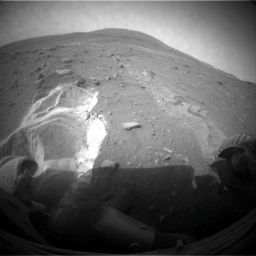 Martian powder
Martian powderWheel slippage during attempts to extricate Spirit from a patch of soft talcum powder-like soil during the preceding two weeks had partially buried the wheels by the rover's Sol 1899 (May 6, 2009). The rover took this image with its front hazard-avoidance camera that sol. With Spirit in the position shown here, the rover team temporarily suspended driving attempts while studying the ground around Spirit and planning simulation tests of driving options with a test rover at JPL. Driving attempts between the time Spirit took a similar image (PIA12002) 10 sols earlier and when this image was taken moved the rover a total of about 36 centimeters (14 inches). While driving backwards, the rover drags its right front wheel, which no longer rotates. For scale, the distance between the wheel tracks is about 1 meter (40 inches). This view is looking northward, with Husband Hill on the horizon.
Credit: NASA / JPL-Caltech
By all accounts, the sands of Ulysses, as the powdery patch is known, is the most challenging predicament in which either rover has found itself. Despite the odds, this is a rover and a team that has a history of never giving up.
“I’m an optimist,” said Arvidson, who has long espoused that Spirit is not stuck but “mobility impaired,” seemingly convinced it will rove on out of Troy and get back on track to Goddard and von Braun. “Back when we decided not to drive and do a stand down on Sol 1900, we were still making progress on the last drive until left middle wheel stalled. That’s why I say we’re not stuck, but mobility impaired. Are we in a bad situation? You bet-ya. It is a tough situation, worse than any situation either rover has been in before. The probability of getting out? I can’t tell you. I am looking forward to getting to von Braun and Goddard at some point during this mission,” he added quickly. “The fact that we’ve been going for 5.75 years rather than 90 days or 180 days suggests this vehicle is resilient. I’m not sure we’ll get out though.”
If Spirit does get out, Arvidson said, the rover will continue on to Goddard and von Braun, a deep house-sized pit, likely another bigger impact crater, and an unusual mound. Putting the Goddard and von Braun stories into the bigger story of the explosive volcanism that once fired up the area, he said, would really strengthen our regional understanding of the processes. “We do already know based on the sulfate deposits we’ve been measuring in Troy and the three other places, together with the opaline silica discovery of last year that this place was warm and wet -- steam eruptions, may have been hydrothermal pools billions of years ago. It would be nice to extend that to a more regional basis by heading south to these beautiful volcanic exposures we call von Braun and Goddard.”
The potholes and obstacles on the road ahead are the unknowns -- whether the pointed rock is loose and benign or deeply emplaced and dangerous, how deep the powdery soil is, whether the rover can move without slipping too much. "The investigations of the rover embedding and our preparations to resume driving have been extensive and thorough," said Callas. "We've used two different test rovers here on Earth in conditions designed to simulate as best as possible Spirit's predicament. However, Earth-based tests cannot exactly replicate the conditions at Troy."
That’s because Mars is Mars and we have no samples as of yet of surface soils or rocks or sulfate-rich powdery soils to really have a solid handle on what Spirit is up against.
Flexibility and adaptability will be key. "Once we eventually start turning wheels on Mars, it's going to be so important that we take our time to assess the moves very carefully and whatever plan we go forward with, we're going to have to be prepared to adjust that plan,” is how principal investigator Steve Squyres described the overall strategy to the MER Update recently. "We've learned all we can from testing on Earth. The real knowledge base is going to come from moving the vehicle on Mars.”
The action begins Monday. Though the word ‘action’ may be overstating it. As Callas put it: “It’s kind of like watching your grass grow.”
Whatever happens and whenever it happens, everyone agrees the process will provide teachable moments. "Mobility on Mars is challenging, and whatever the outcome, lessons from the work to free Spirit will enhance our knowledge about how to analyze Martian terrain and drive future Mars rovers," said McCuistion. And maybe even avoid such powdery pitfalls in the future. Hindsight is still better than foresight and this is one sand trap that could not have been avoided because it was completely hidden.
Everyone also seems to agree now that it’s either possible or probable, depending on who you ask, that Spirit might not get out. “Spirit has surprised us on many occasions doing amazing things and we’re all very hopeful we’ll get out of this,” said Stroupe. “But we are concerned about the possibility of Spirit’s roving mission coming to an end.”
If that comes true, what a history-making mission it’s been. This intrepid robot field geologist has been roaming around Gusev Crater for nearly six Earth years, five and a half years longer than anyone ever dreamed and is responsible for “some of the most spectacular investigations done on surface of Mars,” as McCuistion put it.
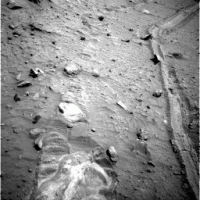 First move in months
First move in monthsSpirit returns thumbnail images from the navigation camera to Earth to document drives. This animation documents Spirit's first drive sequence in 142 sols, on its Sol 2078 (Nov. 6, 2009), as its engineers prepared to attempt to extricate the rover from the powdery pit in which it is embedded at Troy.Credit: NASA / JPL / animation by Eduardo Tesheiner
Still, in the wisdom of the great American philosopher and NY Yankee catcher Yogi Berra, it isn’t over until it’s over. Even if Spirit becomes permanently embedded, it doesn’t necessarily mean lights out. The beloved robot and its instrumentation could be transformed into a weather station or a crude seismometer, among other things, offered Callas.
Truth told though, the team isn’t anywhere near ready to go there yet. “Someday when these rovers comes to an end … we’ll be sad to see them go,” said Stroupe. “But we’re not ready to let go yet and we don’t plan to let go yet. We still have a lot of work to do.”
Stroupe and three other rover drivers will be the main engineers staffing the extrication drives. They will be helped by others as the effort proceeds over coming months. And, another note of interest: the importance of the extrication means the commanding of Spirit will be by a bigger team that includes more than the rover drivers who develop the mobility commands for the day, a team that has a track record of taking on “impossible” challenges.
The MER team at large in fact is charged and ready to roll. “It’s been a great ride,” said Arvidson, who’s been with the mission -- and Spirit in particular -- for a decade. “And we’re itching to go Monday.” Added Callas: “If there’s a way to get the rover out, we will find it.”
A full report of the rovers' adventures this month will appear in the November edition of the Mars Exploration Rover Update, posting at the end of the month. In the meantime, check out The Planetary Society Weblog at: http://planetary.org/blog/
To follow sol-by-sol events, check out NASA-JPL's Free Spirit website at: http://marsrover.nasa.gov/newsroom/free-spirit.html
Support our core enterprises
Your support powers our mission to explore worlds, find life, and defend Earth. You make all the difference when you make a gift. Give today!
Donate

 Explore Worlds
Explore Worlds Find Life
Find Life Defend Earth
Defend Earth


